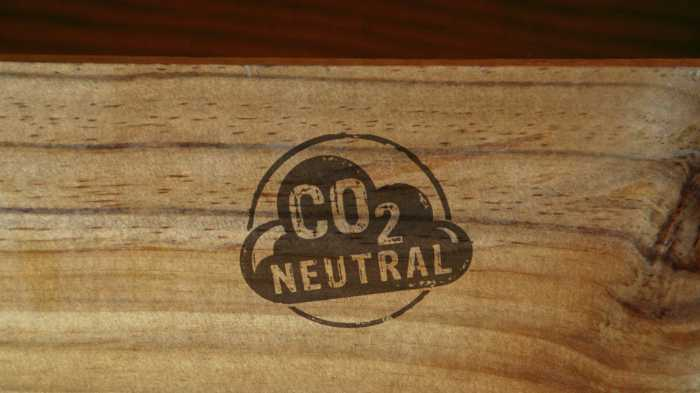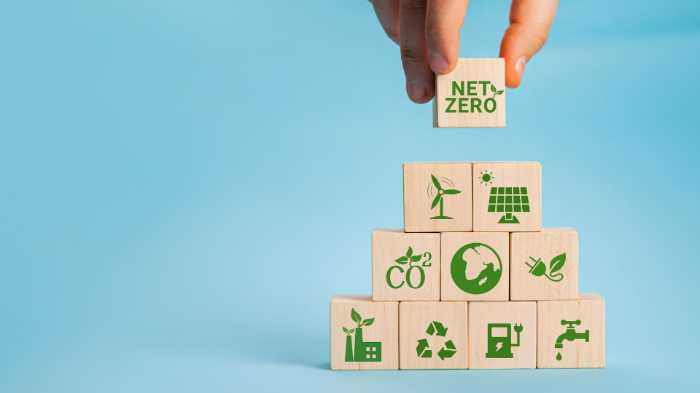When it comes to going green, there are a lot of options to choose from. You can install solar panels, switch to energy-efficient appliances, or even buy a hybrid car. But what about your home or office? What can you do to make your property more environmentally friendly? One option is to make your building carbon-neutral or net zero. But what’s the difference between carbon-neutral and net-zero? In this blog post, we will discuss the differences between carbon neutrality and net zero and explain why you should go for net zero whenever possible!
- What is carbon neutrality vs. net zero?
- Does carbon neutral mean zero emissions?
- How can you achieve carbon-neutral status?
- How can you achieve net-zero emissions?
- FAQs
What is carbon neutrality vs. net zero?
Carbon neutrality and net zero are often used interchangeably, but there is actually a subtle difference between the two terms. Carbon neutrality refers to achieving a balance between emitting carbon into the atmosphere and sequestering or offsetting an equal amount of carbon. In other words, it is possible to be carbon neutral without reducing your overall carbon footprint.
Net-zero, on the other hand, refers to completely offsetting your carbon emissions through sequestration or offsets. This means that your net emissions are zero, although your total emissions may still be positive. In order to achieve net-zero status, you must first reduce your emissions as much as possible and then offset the remaining emissions. For example, you might install solar panels to reduce your energy consumption and then purchase carbon credits to offset your remaining emissions. Ultimately, net-zero is the more ambitious goal, but both carbon neutrality and net zero represent important steps in combating climate change.
Does carbon neutral mean zero emissions?
No, “carbon neutrality” and “zero emissions” are not the same thing. Carbon neutrality simply means that the net carbon dioxide emissions of an entity (a person, a company, a country, etc.) is zero. This can be accomplished in two ways: either by reducing emissions or by offsetting them. So, for example, a company might reduce its emissions by investing in energy-efficient technologies or by switching to renewable energy sources.
Alternatively, it might offset its greenhouse gas emissions by investing in projects that work for carbon dioxide removal from the atmosphere, such as planting trees. Either way, the goal is to achieve net-zero emissions. Zero emissions, on the other hand, would mean that an entity is completely eliminating all carbon dioxide emissions – something that is much more difficult (though not impossible) to achieve.
How can you achieve carbon-neutral status?

The climate crisis is one of the most pressing issues of our time, and we all need to do our part to reduce our carbon footprints. One way to do this is to become carbon neutral, which means offsetting all of the carbon dioxides that you produce each year. Carbon neutrality is important because it helps to protect the environment and slow down climate change. There are a number of ways that you can achieve carbon neutrality, and the best approach depends on your individual circumstances.
1. Invest in green energy
One way to achieve carbon-neutral status is to invest in green energy. This can be done by investing in renewable energy sources such as solar and wind power or by investing in low-carbon technologies such as electric vehicles. By investing in green energy, we can reduce our reliance on fossil fuels and help Combat climate change. In addition, investing in green energy can create jobs and boost the economy. So not only is it good for the environment, but it’s also good for the economy. Everyone wins!
2. Plant trees
Planting trees is one approach that individuals and organizations can take to become carbon neutral. Trees absorb carbon dioxide from the atmosphere and release oxygen back into it. In this way, they help to regulate atmospheric levels of greenhouse gases and limit global warming. Furthermore, trees provide numerous other environmental benefits, such as improving air quality, conserving water, and reducing soil erosion. Thus, planting trees is an effective way to help address the global issue of climate change while also providing other societal benefits.
3. Reduce energy consumption
One popular way to become carbon neutral is to reduce energy consumption. By making simple changes in your daily routine, you can have a big impact on your carbon footprint. For example, instead of leaving lights on when you leave a room, make it a habit to turn them off. You can also save energy by unplugging electronics that are not in use and using power strips to easily turn off multiple devices at once. In the winter, dress warmly and turn the heat down a few degrees. In the summer, take advantage of natural ventilation by opening windows and using fans instead of air conditioning. Every bit counts when it comes to reducing energy consumption, so do your part to help achieve carbon-neutral status.
4. Drive down emissions
There are many ways to reduce carbon emissions, and each one makes a difference. One way is to switch to energy-efficient appliances. This can help reduce the amount of electricity you use, and it can also help save money on your utility bills. Another way to reduce GHG emissions is to drive less by carpooling, walking, or biking more. Public transportation is also a great option for reducing emissions. Finally, you can also help reduce emissions by recycling and composting. All of these actions can help us move closer to a carbon-neutral future.
You can’t improve what you don’t measure.
Free Verified Carbon Calculators.
Erase Your Carbon Footprint in less than 5 Minutes
Personal Carbon Footprint Calculator
Business Carbon Footprint Calculator
5. Carbon Credits
Carbon credits are a way of offsetting carbon dioxide emissions. They provide a financial incentive for businesses and individuals to reduce their carbon footprint. One carbon credit is equivalent to one tonne of carbon dioxide. Carbon credits can be bought and sold on the open market. They can be used to offset emissions from activities such as flying, driving, and heating homes. There are two types of carbon credits: voluntary and regulatory. Voluntary carbon credits are not mandated by law. They are bought and sold voluntarily by businesses and individuals who want to offset their carbon emissions.
Regulatory carbon credits are created by governments in order to meet emissions targets set by international agreements, such as the Kyoto Protocol. Carbon credits can be used to fund projects that reduce global emissions, such as planting trees or investing in renewable energy. In this way, they help to reduce the amount of additional carbon dioxide in the atmosphere and combat climate change.
How can you achieve net-zero emissions?

Achieving net-zero GHG emissions is important for many reasons. It means that a company or individual is taking responsibility for their carbon emissions and working to offset them. This can have a positive impact on both the environment and the economy. There are many ways to achieve net-zero carbon emissions, and each company or individual will have to find the best way for them. Here are five different ways to achieve net-zero emissions:
1. Remove carbon dioxide from the atmosphere
As the world works to become net zero, there are two main approaches: reducing emissions and removing carbon dioxide from the atmosphere. Removing carbon dioxide can be done through natural processes like photosynthesis and through man-made processes like direct air capture. Direct air capture is a process where carbon dioxide is pulled from the atmosphere and then stored or used in other products. This approach is still in development, but it has the potential to be a powerful tool in the fight against global warming.
2. Insulation
One way to become more energy-efficient is by improving the insulation in your home. By keeping the heat in during the winter and out during the summer, you can reduce your energy consumption and save money on your utility bills. There are a variety of insulation options available, so it’s important to do your research to find the best option for your home.
3. Solar panels
Solar panels allow households to generate their own electricity, which can then be used to offset the carbon emitted from other activities, such as driving or using natural gas. Households with solar panels can also sell any excess electricity that they generate back to the grid, further offsetting their carbon footprint. While solar panels are not the only way to have net-zero emissions, they are an increasingly popular option for those looking to reduce their impact on the planet.
4. Carbon offsets
One way to become net zero is to offset your carbon emissions. Carbon offsetting is a way of counteracting your emissions by investing in projects that reduce carbon dioxide in the atmosphere. For example, you could offset your emissions by planting trees or investing in wind energy. Carbon offsets can be used to offset emissions from travel, business, or even your entire lifestyle.
The important thing is to find a reputable carbon offset provider and make sure that the offsets you purchase are verified. Otherwise, you run the risk of offsetting your emissions without actually making a difference. When done correctly, carbon offsets can be an effective way to have net-zero carbon emissions.
The benefits of carbon neutrality and net-zero emissions
There are many benefits to carbon neutrality and net-zero emissions:
- By reducing or eliminating greenhouse gas emissions, we can help to slow down the warming of the planet. This is important not only for the environment but also for public health.
- Carbon neutral and net-zero emissions can help to reduce air pollution, which has been linked to a variety of health problems.
- By promoting carbon neutrality and global net-zero emissions, we can encourage businesses and individuals to adopt cleaner energy sources and technologies.
- Carbon neutrality and net-zero carbon emissions can also help to boost the economy. Investing in renewable energy creates jobs in the engineering and construction industries while also reducing our reliance on imported fossil fuels.
- Transitioning to a low-carbon economy can make us more competitive in the global marketplace.
- By achieving carbon neutrality and net-zero emissions, we can set an example for the world to follow.
Final words: Difference between carbon-neutral and net-zero
When it comes to carbon neutrality and net-zero emissions, there is no one-size-fits-all solution. Each individual or business will need to find the approach that works best for them. But by becoming carbon neutral or achieving net-zero emissions, we can take a major step forward in the fight against climate change.
FAQs

How can individuals reduce their carbon emissions?
There are many ways that individuals can help to reduce their carbon emissions. They can start by removing additional carbon dioxide from their day-to-day operations. This can be done by driving less, flying less, and eating less meat. Another way to reduce emissions is to remove existing carbon dioxide from the atmosphere. This can be done by planting trees or investing in carbon capture technologies. Finally, individuals can offset their emissions by offsetting unavoidable emissions with credits for avoided emissions. By taking these measures, individuals can help to reduce their carbon footprint and move closer to a net-zero carbon future.
What impact do greenhouse gas emissions have on our environment?
Greenhouse gas emissions refer to the release of climate-heating gases into the atmosphere. These gases trap heat, causing the Earth’s temperature to rise. This, in turn, can lead to a number of problems, such as melting glaciers, rising sea levels, and more extreme weather conditions. There are a number of ways to reduce greenhouse gas emissions, such as avoiding emissions from deforestation and investing in renewable energy sources. A net-zero carbon emissions strategy is one that aims to avoid all emissions from human activity. This is a challenging goal, but it is essential if we are to avoid the worst impacts of climate change.
What are direct emissions?
Direct emissions are the emissions produced by an individual, company, or other entity. These emissions can come from a variety of sources, including manufacturing processes, transportation, and the use of fossil fuels.
What is carbon negative?
Carbon dioxide is a greenhouse gas that contributes to global warming. To be carbon negative means to remove more carbon dioxide from the atmosphere than you emit. This can be accomplished by planting trees or other plants which act as carbon sinks. Carbon sinks absorb carbon dioxide and store it in the Earth rather than releasing it into the atmosphere, also called soil carbon sequestration. Alternatively, some businesses capture carbon dioxide emissions and store them underground. Reducing your carbon footprint has an environmental benefit beyond climate change mitigation; it can also help reduce smog and improve air quality.
What is climate-positive?
Climate-positive means taking action to reduce greenhouse gas emissions beyond what would be achieved by solely relying on technology that removes carbon dioxide from the atmosphere. The goal is to achieve net-negative emissions, or more carbon dioxide removed from the atmosphere than emitted. This can be accomplished through a combination of mitigation measures, such as renewable energy and energy efficiency, and negative emissions technologies, such as carbon capture and storage.
Savvy stakeholders are also reading…

Dean Emerick is a curator on sustainability issues with ESG The Report, an online resource for SMEs and Investment professionals focusing on ESG principles. Their primary goal is to help middle-market companies automate Impact Reporting with ESG Software. Leveraging the power of AI, machine learning, and AWS to transition to a sustainable business model. Serving clients in the United States, Canada, UK, Europe, and the global community. If you want to get started, don’t forget to Get the Checklist! ✅
